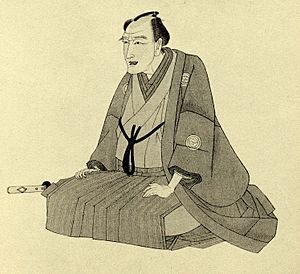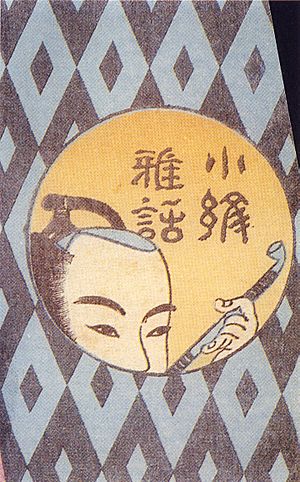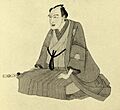Santō Kyōden facts for kids
Santō Kyōden (山東 京伝, born September 13, 1761, in Edo – died October 27, 1816) was a talented Japanese artist, writer, and even a tobacco shop owner during Japan's Edo period. His real name was Iwase Samuru (岩瀬 醒), but many people knew him as Kyōya Denzō (京屋伝蔵). He started his career drawing pictures for other writers' books. Later, he began writing his own popular stories called Kibyōshi and Sharebon. Kyōden often mentioned his shop in his books to help sell more products!
His writing career changed because of new laws called the Kansei Reforms. These laws tried to stop writers and publishers from creating stories about certain places like the Yoshiwara or anything the government thought was "bad for society." Because he was punished in 1791, Kyōden started writing a different kind of book called Yomihon, which were more serious and taught lessons. By the 1790s, Santō Kyōden was a household name, and some of his books sold as many as 10,000 copies! This was a huge number for that time.
Contents
Growing Up
Santō Kyōden was born in Fukagawa, a part of Edo (which is now Tokyo). His family, the Iwase family, were pawnbrokers, meaning they lent money in exchange for valuable items. Kyōden was the oldest of four children. He had a younger brother, Iwase Momoki, who also became a famous writer using the name Santō Kyōzan. He also had two younger sisters named Kinu and Yone. As a child, his name was Jintarō.
Kyōden started learning to read and write when he was nine years old. He read many different kinds of popular books, like aohon (blue books), kurobon (black books), and akahon (red books). He also practiced by copying other authors' works. His father, Denzaemon, gave him a special desk when he started studying, and Kyōden used that same desk until he died.
Writing and Art Career
Ukiyo-e Art
Kyōden began his career by studying ukiyo-e, which are Japanese woodblock prints. These prints often showed scenes from the "floating world," like the entertainment district of Yoshiwara. He learned from a famous artist named Kitao Shigemasa. Kyōden started illustrating books under the pseudonym (a pen name) Kitao Masanobu. He first became known for drawing pictures for other authors' stories.
His artwork can be found in many museums around the world, including the Harvard Art Museums, the Fine Arts Museums of San Francisco, the Museum of Fine Arts, Boston, the University of Michigan Museum of Art, the Portland Art Museum, the British Museum, the Brooklyn Museum, the Yale University Art Gallery, the Art Institute of Chicago, the Minneapolis Institute of Art, the Metropolitan Museum of Art, the Chazen Museum of Art, the Philadelphia Museum of Art, the Los Angeles County Museum of Art, and the Indianapolis Museum of Art.
Kibyōshi Books
In the 1780s, Kyōden started writing his own kibyōshi books, which means "yellow covered" picture books. He used the name Santō Kyōden for these. Interestingly, some of his kibyōshi were written by Santō Kyōden and illustrated by Kitao Masanobu, showing his two different roles! His books became very popular around 1785. In 1793 alone, Kyōden wrote thirteen kibyōshi. He kept writing them until this type of book became less popular due to new censorship laws during the Kansei Reforms.
Kyōden's first sharebon book, which means "book of manners," was published in 1785. These books were like guidebooks that taught people how to act in places like the Yoshiwara entertainment district.
In 1789, Kyōden faced trouble for his illustrations in a book called Koku bykau mizukagami. The government didn't like this work, and Kyōden was fined for his drawings. After this, he continued to illustrate, but only his own books. This wasn't his only punishment. Two years later, Kyōden was put in handcuffs for fifty days because of three sharebon books he had written.
Others were also punished. Kyōden's father was scolded, and the two officials who had approved the books were fined and sent away from Edo. The publisher of Kyōden's books, Tsutaya Jūzaburō, had half of his money taken by the government. This was because Kyōden's books broke the new publishing rules of the Kansei Reforms. Right after his punishment, Tsutaju said sorry in public and admitted he had pushed Kyōden to release those books. Kyōden himself had been unsure about publishing them because of their content. It seemed Kyōden was trying to avoid more trouble, as his earlier punishment was still fresh in his mind.
Ironically, these punishments made Kyōden's books sell even more! Rumors spread that he would never write again. Tsutaju, the publisher, used these rumors to his advantage by reprinting second editions of Kyōden's most popular kibyoshi. Because of all this, Kyōden soon stopped writing gesaku (playful writings).
Yomihon Books
After his punishment in 1791, Kyōden changed his focus to yomihon, which means "books for reading." These books were usually longer, more dramatic, and aimed to teach lessons, unlike his earlier, more humorous stories. Kyōden's first yomihon was Tzuzoku Taiseiden, or "Popular Biography of Confucius." In the fall of that year, Kyokutei Bakin, who would later write the famous Nansō Satomi Hakkenden ("Tale of Eight Dogs"), became Kyōden's student.
Overall Career
It's thought that Kyōden was involved in about 200 different works during his career. He is believed to have written 125 of them himself. However, this number might be high because it could include re-released versions of his books.
Kyōden was paid differently from most other writers at the time. Most authors received a small payment if their books became popular. But Kyōden was paid regularly for each manuscript he wrote. The downside was that when his publisher, Tsutaju, re-released popular books, Kyōden didn't get paid again for those, since he was only paid for the original manuscript.
Kyōden was very good at creating an image for himself as a writer. In his books, he would describe the challenges he faced, like trying to meet deadlines and always needing to write new stories for his publishers.
Tobacco Shop
Advertisements and Promotions
Kyōden was not just a famous writer; he also owned a successful tobacco shop called "Kyōya Denzō's Shop." It opened in the fall of 1793 in Ginza. One clever way Kyōden increased sales was by putting advertisements for his shop right inside his books! While this is common today, it was a new idea in Japan back then. To make sure people knew it was an ad and not part of the story, he would put a box around it and announce, "this is an advertisement." Even his pen name, Santō Kyōden, hinted at his shop's location. "To" means "to the East" of "san" (the mountains) in "kyō" (Kyōbashi). "Den" was a reference to his name as a merchant, Denzaburo.
Kyōden also used his celebrity status to attract customers. He made sure he was well-known as a writer before opening his shop. This way, people would want to visit the shop hoping to meet "Japan's first celebrity writer." However, it seems Kyōden often left the daily running of the shop to his father. He would usually stay in his office on the second floor to keep writing.
Goods at His Shop
Kyōden's tobacco shop sold items related to smoking, like tobacco pipes and smoke pouches. But his store also sold other things. He sold a "cure-all pill" called tokushogan and special "reader's pills." These "reading pills" became a very popular item at his shop. Kyōden also sold various paper products.
Personal Life
Kyōden's First Marriage
Santō Kyōden married his first wife, Okiku (also known as Kikuzono), in February 1790. Before they were married, starting in 1786, Kyōden began mentioning Okiku by name in his books. He continued to do this until she passed away. It's thought that when they married in 1790, Okiku was between twenty-six and twenty-nine years old. Sadly, their marriage was short. Okiku died less than four years after they were married.
Kyōden's Second Marriage
It is believed that around 1797, Kyōden met his second wife, Tamanoi, who later went by the name Yuri. At that time, Kyōden was forty years old, and Yuri was estimated to be about twenty-three. Kyōden not only married Yuri but also adopted her younger sister, whom he named Tsuru. A writer named Bakin said that Kyōden had originally planned to adopt Yuri's younger brother, but he died at age twenty. This marriage was also cut short, this time by Kyōden's own death.
Later Years and Death
Before Santō Kyōden passed away, he had been complaining of chest pains. These pains started in either 1813 or 1814, and Kyōden felt them when he went for walks. He stayed indoors until his chest pain got better in the summer of 1815. After that, Kyōden met with friends and attended various gatherings. He died in July 1816.
Kyokutei Bakin believed that Kyōden worked himself to death. However, Mizuno Minoru, a researcher of old Japanese literature, thinks Kyōden died of a heart attack. He was buried in the Eko-in cemetery.
Tobacco Shop and Yuri After Kyōden's Death
After Kyōden's death, his second wife, Yuri, struggled to keep his tobacco shop running. Kyōden's brother, Kyōzan, moved into Kyōden's house to help her with the business. But according to Kyōzan and Bakin, Yuri was very sad and struggling. Her condition seemed to get worse after Kyōzan moved in. Bakin said that the way she spoke and acted was strange. This continued until she died in February 1818. Bakin partly blamed Kyōzan, saying he made her condition worse and also wasted the rest of the money from Kyōden's tobacco shop.
Popularity After Death
Kyōden remained somewhat popular right after he died. His lasting fame can be seen in the many books written about him. The first was Iwademo no ki by Kyokutei Bakin in 1819. The second was Santō Kyōden ichidaiki, published in 1834 by an unknown author. Also in 1834, Kyōden was named one of the "six immortals" of gesaku (playful writings) by Bokusentei Yukimaro. For the next hundred years, interest in Kyōden and gesaku generally decreased. There were a few exceptions, like Santō Kyōden in 1916 by Miyatake Gaikotsu and Koike Tōgorō's Santō Kyōden no kenkyu in 1935.
Selected Works
Kibyōshi
- Those Familiar Bestsellers (御存商売物, Gozonji no Shōbaimono) (1782)
- Musukobeya (令子洞房) (1785)
- A Connoisseur's Words (通言総籬, Tsūgen Sōmagaki) (1787)
- Three Madames and their Dirty Tale (古契三娼, Kokei no Sanshō) (1787)
- Shigeshige Chiwa (繁千話) (1790)
- Shikake Bunko (仕懸文庫) (1791)
- Nishiki no Ura (錦之裏) (1791)
- Shōgi Kinuburui (娼妓絹籭) (1791)
Yomihon
- Chūshin Suikoden (忠臣水滸伝) (1799)
- The Tale of the Three Thousand Year Flower (優曇華物語, Udonge Monogatari) (1804)
- Sakura Hime Zenden Akebono no Zōshi (桜姫全伝曙草子) (1805)
Historical Works
- Kinsei Kiseki-kō (近世奇跡考) (1804)
- Curios (骨董集, kottōshū) (1814–15)
Other Names
It was common for authors and illustrators in Japan to use different names depending on the type of writing or art they were creating. Santō Kyōden was one such artist and writer who used many different names:
- For his Kyōka, or "mad-verse" poetry, he used the name Migaru no Orisuke.
- For his ukiyo-e art and book illustrations, he used names like Kitao Masanobu, Kitao Rissai Masanobu, Kitao Sessai Masanobu, or just Masanobu.
- His later, more old-fashioned works written before his death were under the name Seisei Rōjin.
Images for kids
See also
 In Spanish: Santo Kyoden para niños
In Spanish: Santo Kyoden para niños





